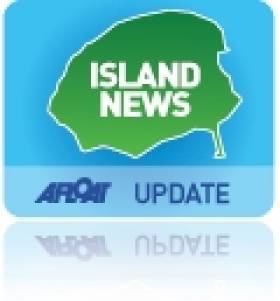Displaying items by tag: OCEA
Mauritius-Bound Ferries Finally Bid Galway Farewell
First to be loaded was the Clann na nOileáin on Wednesday in an operation than took four-hours while on Friday her sister Clann Eagle I took six-hours to be winched safely onto the cargo-deck during freshening winds.
It is ironic that since Thor Gitta 's arrival to the port's Dún Aengus Dock on 5 April that it would also nearly be the same time taken for the estimated 25-day delivery voyage of the ferries to the Indian Ocean island.
During the 8,300 mile journey Thor Gitta will make several port of calls with the first call to La Rochelle. The Bay of Biscay port is the next largest port south of Les Sables d'Olonnes, where the fast-ferries where built at the OCEA boatyard for her original owners Bád Arann Teoranta which traded as Aran Direct on routes from Rossaveal to the islands.
Thor Gitta was built in 1996 and is also designed to carry 364 TEU (twenty-foot equivilant unit) containers and belongs to an-eight strong fleet operated by the Danish company, Thor Rederi A/S of Svendborg.
One of the reasons why the heavylift vessel was delayed in loading was to ensure the correct positioning of the ferries so not to further disrupt other port call cargo allocation while on the long repositioning voyage to Mauritius.
The 4,078 tonnes cargsoship is also scheduled to make en-route calls to Pointe Noir in the Congo, Cape Town and Pemba in Mozambique before finally reaching the southern Indian Ocean destination.
When the ferries were completed in 2005 and 2006 they were valued between €5-6m but they only served up to September 2008 when the 243 passenger aluminium built craft were laid-up at the Connemara harbour due to financial difficulities.
This led to the company going into receivership and the vessels were put up for auction in Galway last February. Despite bids reaching €950,000, they were withdrawn at the auction hosted by the Cork based auctioneer, Dominic J. Daly.
In the following month the fast-ferries were sold to the French owner for a new career based from the island state which is in the Mascarene Islands. Mauritius is neighboured by the smaller islands of Agalega, Cargados Carajos, Rodrigues and the French island of Réunion some 200km to the southwest.
Aran Island Fast-Ferries Sold to Mauritius Operator
The sale follows a previous attempt to dispose of the 234-passenger capacity ferries at an auction in Galway last month. Despite bids reaching €950,000, they were withdrawn at the auction which was also hosted by the Cork based auctioneer.
The vessels remain in Rossaveal but they will be transferred onto a cargoship as 'deck-cargo' to make the long delivery journey across the high seas for the new owners. Mauritius is neighboured by the smaller islands of Agalega, Cargados Carajos and Rodrigues which together form the Mascarene Islands, with the French island of Réunion some 200km to the southwest.

Sisters Clann na nOileáin and Clann Eagle I moored at Rossaveal. Photo
Jehan Ashmore / ShipSNAPS
With a streamlined aluminium 26m mono-hull design the vessels are capable of 19.7 knots. When the craft were constructed in 2006 they were worth between €5 and €6m. The pair were built in France by the OCEA boatyard at Les Sables d'Olonne, on the Bay of Biscay coastline, for Bád Arann Teo (trading as Aran Direct).
The company which went into receivership, operated on routes between Rossaveal and the Aran Islands (Oileáin Árann) of Inishmore (Inis Mór) Inishmaan (Inis Meáin) and Inisheer (Inis Oírr).
In recent years, Aran Direct had intended to introduce a larger passenger-only catamaran ferry on a new route between Galway and Kilronan, the capital of Inishmore and the largest of the three islands.
The fast-craft catamaran envisaged for the route was the U.S. based, 37m Harbour Lynx (2003/427grt) formerly Angel of Freedom, with a capacity for 300 passengers.To be renamed Aran Princess, the vessel was scheduled to take only an hour's passage time across Galway Bay.
In addition the revived route would have been the first direct 'passenger' carrying link between Galway City to the Aran Islands, since the closure in 1988 by CIE (Córas Iompair Éireann) of the three-hour route operated by the Naomh Éanna (1957/438grt).

























































